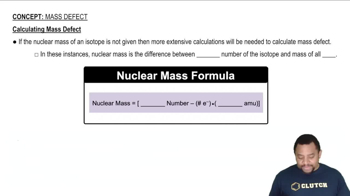Here are the essential concepts you must grasp in order to answer the question correctly.
Mass Defect
Mass defect refers to the difference between the mass of an atomic nucleus and the sum of the masses of its individual protons and neutrons. This discrepancy arises because some mass is converted into binding energy, which holds the nucleus together. The mass defect is crucial for calculating the binding energy and understanding nuclear stability.
Recommended video:
Binding Energy
Binding energy is the energy required to disassemble a nucleus into its constituent protons and neutrons. It can be calculated using the mass defect and Einstein's equation, E=mc². A higher binding energy per nucleon indicates a more stable nucleus, as it implies that more energy is needed to break the nucleus apart.
Recommended video:
Stability of Nuclei
The stability of a nucleus is determined by its binding energy and the ratio of neutrons to protons. Nuclei with higher binding energy per nucleon are generally more stable, as they are less likely to undergo radioactive decay. Comparing the binding energies of different nuclei allows us to assess their relative stability and predict their behavior in nuclear reactions.
Recommended video:
Intepreting the Band of Stability




